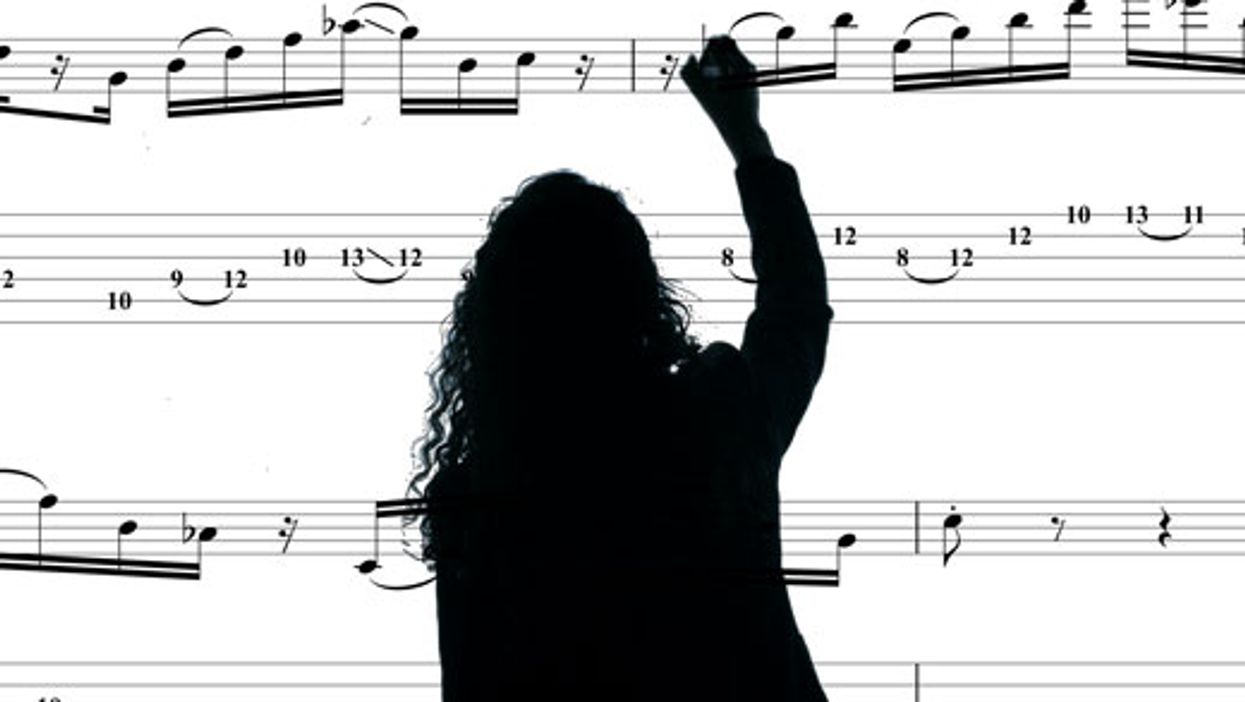Chops: Intermediate
Theory: Intermediate
Lesson Overview:
• Understand how to create a whole-tone scale.
• Learn how to apply the scale in classical, jazz, and rock settings.
• Develop syncopated parts that exploit the nuances of the whole-tone scale.
Click here to download a printable PDF of this lesson's notation.
The whole-tone scale is an elusive and, for most musicians, problematic series of notes. Constructing the scale is rather simple—six whole-steps and you’re there. But because any note of the scale can be considered the root, it does create a sound that seems to wander aimlessly.
This inherent ambiguity is also the scale’s strength. Rather than try to force the scale into something, for lack of a better word, “melodic,” we’ll simply let the scale be mysterious, unsettling, and alchemical.
Before we get to some points of reference and practical uses of the scale, let’s get some fingerings together. In Ex. 1 and Ex. 2, you can see two different whole-tone scales. Since we have only 12 notes to play with and each scale uses six, there are only two scales to remember. As we continue through the lesson, you’ll see that the symmetrical shape of this scale makes playing many of the examples quite comfortable and easy. Now on to the music!
Click here for Ex. 1
Click here for Ex. 2
Classical
Though the whole-tone scale appears sporadically in European classical music before the 20th century, it was the French composer Claude Debussy (1862-1918) who really brought it to the forefront by using it as the basis for several works. Voiles, his famous composition for piano, is composed almost entirely using notes from the whole-tone scale, and the piece emphasizes the scale’s floating and capricious quality. Debussy went so far as to include instructions to play “smoothly and caressing … with tender contentment.” Ex. 3 shows the piece’s opening phrase.
Click here for Ex. 3
Jazz
Most players who have any practical knowledge of the whole-tone scale probably know it from the world of jazz. Almost every solo the jazz pianist and composer Thelonious Monk ever played contains a couple of whole-tone runs. Ex. 4 provides a Monk-eqsue lick over a D7 chord resolving to G. This line colors the D7 chord with G# (the #11 or b5) and A# (the #5). These altered tones give the lick an outside sound.
Click here for Ex. 4
Rock
My personal, all-time favorite use of the whole-tone scale is by King Crimson’s guitarist and composer, Robert Fripp. I think “Fracture,” from the album Starless and Bible Black, is one of the greatest pieces of guitar music ever composed, period. It’s also one of the most challenging pieces you will ever try to play. And it’s also composed exclusively from the whole-tone scale. Ex. 5 offers a variation on Fripp’s masterpiece.
Click here for Ex. 5
Inspired by the preceding examples, I set out to compose my own piece. What resulted is the third movement of my song “The Quince Tree,” which was recorded by Boud Deun on the band’s album Astronomy Made Easy. The composition consists of three different parts, each of which uses the whole-tone scale. These parts are simultaneously played by bass, violin, and guitar (shown in Ex. 6, Ex. 7, and Ex. 8, respectively). The result is a driving, dizzying piece that spirals out of control into the next movement.
Click here for Ex. 6
Click here for Ex. 7
Click here for Ex. 8
Once you get those parts together, check out the clip below to hear how they all interact.
There are many more examples of practical ways to use the whole-tone scale in almost all genres of music. Classical and jazz dominate, from Béla Bartók and Arnold Schoenberg to John Coltrane and Wayne Shorter. But you’ll also find it in recordings by such bands as Kraftwerk and Dream Theater. Even Stevie Wonder’s “You Are the Sunshine of My Life” has a distinctive whole-tone phrase snuck into the intro. So keep your ears open for those haunting and enigmatic sounds, and be sure to incorporate them into your own playing.





![Rig Rundown: AFI [2025]](https://www.premierguitar.com/media-library/youtube.jpg?id=62064741&width=1245&height=700&quality=70&coordinates=0%2C0%2C0%2C0)

![Devon Eisenbarger [Katy Perry] Rig Rundown](https://www.premierguitar.com/media-library/youtube.jpg?id=61774583&width=1245&height=700&quality=70&coordinates=0%2C0%2C0%2C0)







